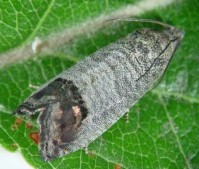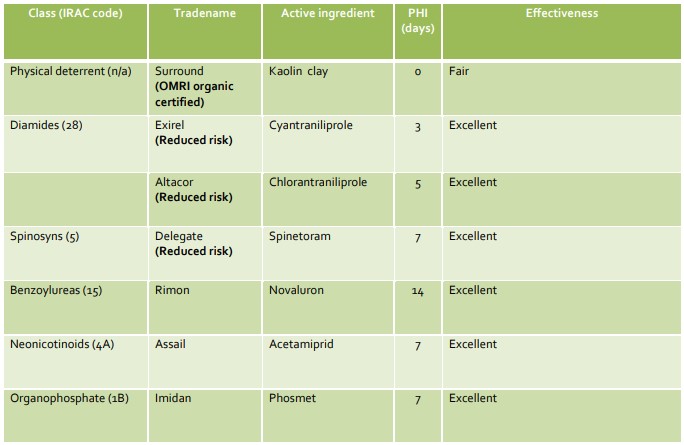Apple Pest Update – Codling Moth Flight Begins
Apple growers in Wisconsin have begun finding codling moth (CM) in pheromone-baited traps over the past two weeks.
Life Cycle and Identification

The codling moth overwinters as a last-instar larva, and pupates in early spring around first-pink. First-generation adults are starting to emerge now. Adults are lightto dark-grey, and around 3/8 inch long, with coppery tips (see Fig. 1). Adult flight will last for the next couple months, with eggs being laid singly on or near the developing fruit throughout this time period. Each egg hatches after approximately a week, and the tiny green caterpillars borrow in the fruit and feed near the surface for a short time before moving to the middle of the fruit to feed on the seeds for three to four weeks. At maturity, the caterpillar will be ½ to 5/8 inches long, and will exit the fruit, drop to the ground, and spin a cocoon. Codling moth have up to three generations per year in Wisconsin.
Monitoring and Management
Management for CM can take place either at the adult stage (mating disruption) or at the larval stage (chemical sprays). Mass trapping, an option for adult control currently under development, was discussed in a previous issue of this newsletter. Regardless of the CM control method being used, it is important to monitor for moths in the spring using pheromone-baited sticky traps. The specifics of how to set up those traps depend if you are using mating disruption to control CM in your orchard.
Using larvicides
Larval control is still an important aspect of codling moth IPM, and the effectiveness of a larvicide can be greatly increased by monitoring and using a degree day model to improve spray timing. If you are not using mating disruption this summer, you can monitor populations using a commercially available CM pheromone lure at a rate of one trap per ten acres. Traps ideally should have been set out prior to bloom, at about head height in the tree canopies. It is especially important to check the traps every few days until you find the first “sustained trap catch”, or when there is on average at least one moth per trap per week for two consecutive weeks.
That point of first sustained trap catch is used for CM as a “biofix”, or as the time when you begin accumulating degree days. First sustained trap catch represents the point at which moth flight begins, and therefore when egg laying begins. Approximately 250-300 degree days after this biofix the majority of the larvae will have hatched, but will not yet be inside an apple, which is the optimal time to spray a larvicide for CM. Degree days can be calculated using your own weather station data (see article explaining degree day calculations in the second issue of this newsletter), or a regional degree day accumulation can be found using the NEWA website and Cornell’s CM model.
A list of available insecticides to control CM in apple is provided in the following table. There are many other tradenames available, and we do not recommend these that are listed above other options. All product recommendations can be found in the Midwest Fruit Pest Management Guide. Additionally, you should always fully read and follow the label before spraying any pesticide.

Using mating disruption
Mating disruption, as a quick refresher, involves permeating the orchard with the codling moth female sex pheromone, which prevents the male moths from being able to key into a specific mating pheromone plume to find the female. This pest control strategy has a couple very strong advantages: there is no residue left on the fruit, and the chemical is safe to non-target organisms. However, mating disruption is not effective in every situation, and is much less effective in small orchard blocks or when moth populations are very high.
In order to make sure the disruption is working in your orchard, monitoring can ensure the males are unable to find the females (or the lures), and can warn you if a spray is still necessary. A total trap catch of over ten CM during this first adult flight indicates the mating disruption is not working, and a back-up insecticide application should be applied. Because of the high prevalence of the mating pheromone, it is recommended to use a stronger lure (5 to 10 mg), to place more traps per acre (2 to 3), and to place the sticky traps higher in the canopy than if you were not using mating disruption.
This article was posted in Apples, Insects and tagged CM.
